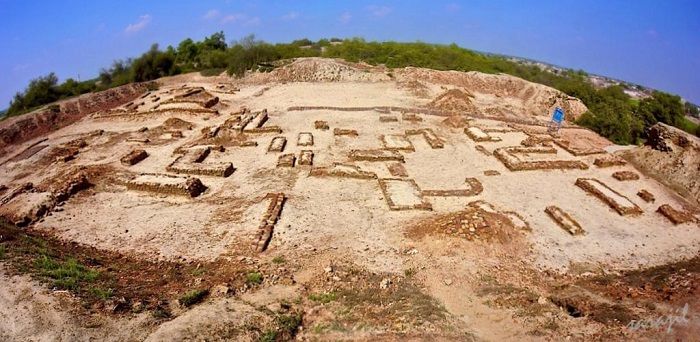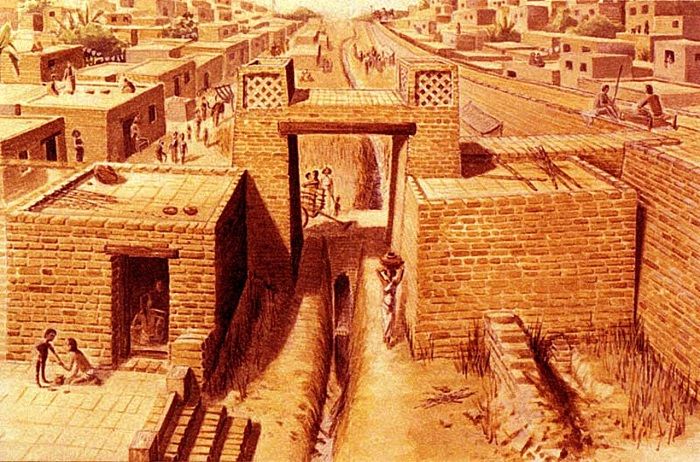The Indus Valley Civilisation, also known as the Harappan Civilisation, is the oldest civilisation in Asia. Extending from northeast Afghanistan to Pakistan and northwest India, it covered approximately 280,000 square miles. It flourished from 2600 to 1900 B.C and is said to have originated around 3000 B.C. Records state that the Indus Valley Civilisation had a population of more than five million at its peak. In 1920s, the first of its several sites, Harappa, was excavated so it came to be known as the ‘Harappan Civilisation.’ New techniques in handicraft were developed by the inhabitants of the Indus River valley. The cities in the Indus Valley civilisation are well-known for their water supply systems, baked brick houses, clusters of large non-residential buildings, urban planning and elaborate drainage system. Only a few weapons have been found at the excavated sites and that hint towards prosperity and peace. Several items indicate the flourishing trade the Indus valley people had with lands as far away as Sumer in southern Mesopotamia. Over 1000 cities/towns have been found of which 406 are in Pakistan, while 616 sites are in India. Some of the most important urban centres of the civilisation were Harappa, Mohenjo-daro, Ganeriwala, Dholavira, and Rakhigarhi.
Why Was It Named As The Indus Valley
Most of the major sites were found in the vicinity of the Indus Valley, so it was named the ‘Indus Valley Civilisation.’ In the 1920s, when the first of its sites, Harappa, was excavated, it also came to known as the Harappan civilisation. Many refer to the civilization as ‘Sindhu-Saraswati Civilisation,’ ‘Sarasvati Culture,’ or the ‘Indus-Saraswati Civilisation,’ as the Ghaggar-Hakra river is recognized with the mythological Sarasvati river by some.
Extent of The Indus Valley Civilisation (IVC)
The IVC extended over parts of Pakistan, north-eastern Afghanistan, Pakistani Balochistan, western India, Maharashtra, and Uttar Pradesh in the east. The Indus sites have also been unearthed in Pakistan’s Khyber Pakhtunkhwa. The largest number of sites are in the Gujarat belt Coastal settlements extending from Sutkagan Dor, Sindh, Haryana, Punjab and Rajasthan.
The IVC sites have largely been found on rivers, and also on islands and the ancient seacoast. More than 600 sites have been discovered along the dried up river beds of the Ghaggar-Hakra River and its tributaries. More than 400 sites have been unearthed along the Indus and its tributaries.

Image Credit: https://en.wikipedia.org
Town Planning
The excavations reveal an advanced urban culture in the Indus Valley Civilisation. One can clearly see the knowledge of town planning, and efficient municipal system that emphasised hygiene. The world’s first known urban sanitation systems involving hydraulic engineering can be seen in Mohenjo-daro, Harappa and the recently excavated site of Rakhigarhi.

Image Credit : https://arstechnica.com/science/2017/02/dramatic-new-discoveries-illuminate-the-lost-indus-civilization/
Water was obtained from wells. There are evidences of rooms that were reserved for washing and bathing purpose. In addition to this, covered drains lining major streets have also been unearthed and all this suggest towards an efficient and advanced drainage system.
The sewerage and drainage system seen in towns of the Indus valley civilization are way more efficient and advanced than those found in many areas of the present day India, Pakistan and contemporary urban sites in the Middle East.
The impressive granaries, protective walls, brick platforms, dockyards and warehouses highlight the planning and architecture of the Harappans. The massive walls of the cities in the Indus valley suggest that they might have dissuaded military invasions and protected the citizens from floods.
The sites do not show any evidence of armies, priests, palaces, kings or temples. Some structures suggest that these might have been granaries. A gigantic well-built bath, ‘the Great Bath,’ was found in one of the cities that suggest that it might have been used as public bath.
Walled citadels suggest that these structures might have been built to divert flood waters. The seals, other similar objects and beads found in the Indus cities are said to have been made from materials brought from distant regions.
Few houses were larger than others, but all of them had access to drainage and water facilities. Personal adornments reveal clear social levelling, however, the society gave an impression of relatively low wealth concentration.
The toilets in the Indus Valley Civilisation used water, which indicates that the cities of Mohenjo-daro and Harappa had flush toilets in mostly all the houses along with a sophisticated sewage system.

Image Credit : http://www.downtoearth.org.in/news/how-climate-change-forced-migration-of-indus-valley-people-towards-ganga-basin-59423
Religion
The excavations of the various sites reveal that the people believed in idol worship. They probably worshipped Mother Goddess apart from some female and male deities. Few seals show animals which look like Rudra and Shiva. A tree is also depicted by another seal that shows the Indus Valley held it to be the ‘tree of life.’ A spirit guarded the tree to keep the evil forces away. Animals like snake, bull and goat portrayed the guardian. The tiger represents the evil force. There is another seal that shows a figure sitting in a way similar to a yoga position and is considered to be a portrayal of a Hindu God.
The sites also suggest that a Father God was worshipped by the Indus people and it might have been the predecessor of the race. Scholars believe that a Mother Goddess that signified fertility was also worshipped by the people. It is also believed that the people might have had faith in amulets, demons, magical rituals, spirits and charms.
Excavations also reveal signs of Sun being regarded as an inordinate God. A small seal that had a figure of a male deity in a seated position has also been found. They might have regarded it holy. Few seals have also revealed a horned figure called ‘Pashupati,’ surrounded by animals like tiger, antelope, buffalo, rhinoceros, deer and elephant.
There are evidences of the existence of ‘Swasthik.’ Meditation and some form of Yoga was also practised by the people of the Indus Valley Civilisation. Ritual bathing was also an important part of their lives for which they had built big bath houses like the one in Mohenjo-daro, which might have been used to perform important rituals for special occasions.
The early days of their culture reveal that initially the people of Indus Valley buried their dead. However, during the later period they probably conducted cremations and kept the ashes in urns, discovered from the burial grounds in pottery items.

Image Credit : http://www.mysteryofindia.com/2016/03/unearthing-civilisation-lothal.html
Language
Several symbols have been unearthed at different sites of the Indus Valley Civilisation. These have been collectively termed as ‘The Indus Script’ by the researchers. The Indus script, however, still remains undeciphered and scholars have not been able to understand the origin of the script. The script shows no signs of change over time.
In 1875, the first seal with Harappan symbols was first published in a drawing by Alexander Cunningham. Since then, approximately four thousand objects with inscriptions have been tracked down.
More than 400 basic signs have been identified but only thirty-one of these four hundred signs have been used more than hundred times whereas the remaining signs were not used frequently. Thus, researchers believe that the Indus script was largely written on perishable items like birch or palm leaves.
Technology
Great accuracy was achieved by the people of the Indus Valley in measuring time, length and mass. They were the first one to develop a system of uniform measures and weights. Indus territories exhibited large scale variations as suggested by a comparison of available objects.
Some new techniques in metallurgy were evolved by the Harappans and they also produced tin, lead, copper and bronze.
Harappans exhibited remarkable engineering skills which is evident especially in the building docks.
In 2001, Archaeologists also discovered that the Indus Valley people had knowledge of proto-dentistry.
In order to test the purity of gold they used a touchstone bearing gold streaks, discovered in Banawali during one of the excavations.

Image Credit : http://www.themysteriousindia.net/40-facts-about-indus-valley-civilization/
Arts and Crafts
Excavations sites have revealed a number of bronze vessel pottery, sculptures, gold jewellery and seals. Anatomically detailed figures in steatite, terracotta and bronze have also been found.
Presence of some dance form has been revealed through various terracotta, stone and gold figurines of girls in dancing position. Monkeys, cows, dogs and bears can also be seen in these terracotta figures.
The Indus Valley women liked to wear earrings, ornate necklaces and bangles, which were made from carnelian, gold, shells, stones and silver.
Excavations also reveal that a wide range of objects including animal figures, children’s toys and games, including cubical dice and whistles were made of terracotta. Some of these crafts are still practised in the subcontinent.
Interesting Facts about Indus Valley Civilisation
- Amongst the four ancient civilisations, the Indus valley civilisation is the largest.
- Sources suggest that the Indus valley may have had a population of over 5 million at its peak.
- Over 1,050 Harappan cities and settlements have been discovered till date.
- During the initial excavations, archaeologists believed that they had discovered cities of children.

Image Credit : https://detechter.com/10-amazing-facts-indus-valley-civilization-will-thrilled-know/
- A 93 miles railway track was laid down by the British using 4,000 year-old Indus Valley bricks.
- The world’s first grid planned cities were found in the Indus Valley civilisation.
- Extraordinary levels of standardization were exhibited by the Harappan towns and cities.
- Though the cities of the Indus Valley Civilisation were densely populated, yet they were not chaotic.
- The drainage systems and sanitation systems in the IVC were far more advanced than any other ancient civilisation.
- Allahdino is the smallest site and Rakhigarhi is the largest site.
- The oldest Harappan site is Haryana’s Bhirrna.
The Indus Valley civilisation had well-built citadels, bathing platforms, granaries and burial grounds. - Burnt bricks of standard sizes were used in order to build all the structures.
- The world’s earliest dockyards existed there.
- The people in the IVC were a pro at dentistry.
- The most precise measurements that humanity had around that time were developed by the Harappan people.
- The world’s first button was invented by the IVC people.
- The world’s oldest signboard was also made by IVC people.
- There is not much evidence that could ascertain the actual cause of the downfall of the civilisation.
- The Indus script has not been deciphered till date.
- Not much is known about the religious beliefs and political structure of the Indus Valley Civilisation.
Learn How Did Indus Valley Civilization Come to an End?


